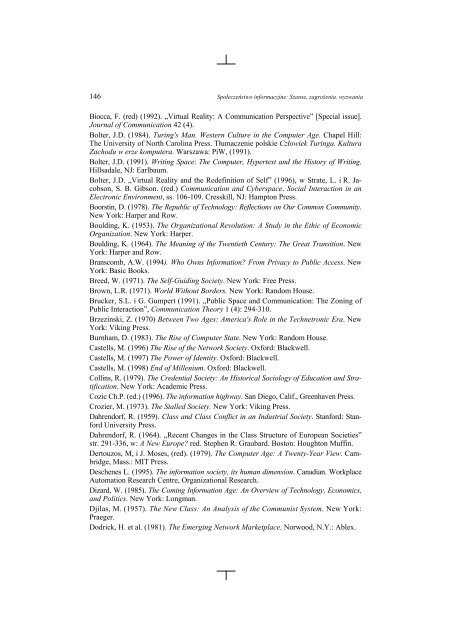Społeczeństwo informacyjne: Szanse, zagro enia, wyzwania
Społeczeństwo informacyjne: Szanse, zagro enia, wyzwania
Społeczeństwo informacyjne: Szanse, zagro enia, wyzwania
You also want an ePaper? Increase the reach of your titles
YUMPU automatically turns print PDFs into web optimized ePapers that Google loves.
146 <strong>Społeczeństwo</strong> <strong>informacyjne</strong>: <strong>Szanse</strong>, <strong>zagro</strong>ż<strong>enia</strong>. <strong>wyzwania</strong><br />
Biocca, F. (red) (1992). „Virtual Reality: A Communication Perspective” [Special issue].<br />
Journal of Communication 42 (4).<br />
Bolter, J.D. (1984). Turing's Man. Western Culture in the Computer Age. Chapel Hill:<br />
The University of North Carolina Press. Tłumaczenie polskie Człowiek Turinga. Kultura<br />
Zachodu w erze komputera. Warszawa: PiW, (1991).<br />
Bolter, J.D. (1991). Writing Space: The Computer, Hypertext and the History of Writing.<br />
Hillsadale, NJ: Earlbaum.<br />
Bolter, J.D. „Virtual Reality and the Redefinition of Self” (1996), w Strate, L. i R. Jacobson,<br />
S. B. Gibson. (red.) Communication and Cyberspace. Social Interaction in an<br />
Electronic Environment, ss. 106-109. Cresskill, NJ: Hampton Press.<br />
Boorstin, D. (1978). The Republic of Technology: Reflections on Our Common Community.<br />
New York: Harper and Row.<br />
Boulding, K. (1953). The Organizational Revolution: A Study in the Ethic of Economic<br />
Organization. New York: Harper.<br />
Boulding, K. (1964). The Meaning of the Twentieth Century: The Great Transition. New<br />
York: Harper and Row.<br />
Branscomb, A.W. (1994). Who Owns Information? From Privacy to Public Access. New<br />
York: Basic Books.<br />
Breed, W. (1971). The Self-Guiding Society. New York: Free Press.<br />
Brown, L.R. (1971). World Without Borders. New York: Random House.<br />
Brucker, S.L. i G. Gumpert (1991). „Public Space and Communication: The Zoning of<br />
Public Interaction”, Communication Theory 1 (4): 294-310.<br />
Brzezinski, Z. (1970) Between Two Ages: America's Role in the Technetronic Era. New<br />
York: Viking Press.<br />
Burnham, D. (1983). The Rise of Computer State. New York: Random House.<br />
Castells, M. (1996) The Rise of the Network Society. Oxford: Blackwell.<br />
Castells, M. (1997) The Power of Identity. Oxford: Blackwell.<br />
Castells, M. (1998) End of Millenium. Oxford: Blackwell.<br />
Collins, R. (1979). The Credential Society: An Historical Sociology of Education and Stratification.<br />
New York: Academic Press.<br />
Cozic Ch.P. (ed.) (1996). The information highway. San Diego, Calif., Greenhaven Press.<br />
Crozier, M. (1973). The Stalled Society. New York: Viking Press.<br />
Dahrendorf, R. (1959). Class and Class Conflict in an Industrial Society. Stanford: Stanford<br />
University Press.<br />
Dahrendorf, R. (1964). „Recent Changes in the Class Structure of European Societies”<br />
str. 291-336, w: A New Europe? red. Stephen R. Graubard. Boston: Houghton Muffin.<br />
Dertouzos, M, i J. Moses, (red). (1979). The Computer Age: A Twenty-Year View. Cambridge,<br />
Mass.: MIT Press.<br />
Deschenes L. (1995). The information society, its human dimension. Canadian. Workplace<br />
Automation Research Centre, Organizational Research.<br />
Dizard, W. (1985). The Coming Information Age: An Overview of Technology, Economics,<br />
and Politics. New York: Longman.<br />
Djilas, M. (1957). The New Class: An Analysis of the Communist System. New York:<br />
Praeger.<br />
Dodrick, H. et al. (1981). The Emerging Network Marketplace. Norwood, N.Y.: Ablex.


